Volvo Group Bundle
Unveiling Volvo Group: How Does It Drive Global Industry?
Volvo Group, a titan in commercial transport and infrastructure, consistently demonstrates its powerful influence. With impressive Q1 2024 net sales figures, the Volvo Group SWOT Analysis reveals the core of its operations and strategic direction. This deep dive explores how this global leader manufactures and markets its diverse range of products.
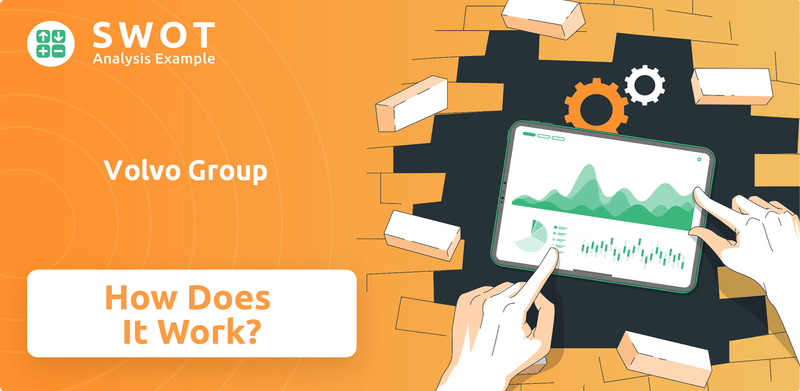
Understanding the Volvo company is vital for investors, customers, and industry analysts alike. From Volvo products like trucks and construction equipment to its commitment to innovation, the Volvo operations and strategic moves in electrification paint a picture of a company shaping the future. This analysis will unravel the complexities of the Volvo business, offering actionable insights into its financial health and growth prospects.
What Are the Key Operations Driving Volvo Group’s Success?
The core of the Volvo Group lies in its comprehensive approach to commercial transport and infrastructure. The Volvo company provides a wide array of products and services designed to meet the needs of various sectors, including transport, construction, and marine industries. Through strategic operations, the Volvo Group aims to deliver value to its customers worldwide.
Volvo's operational processes are highly integrated, encompassing research and development, advanced manufacturing, and a global supply chain. This integration supports the efficient production and timely delivery of products. From trucks and buses to construction equipment and marine engines, the Volvo Group ensures high performance and durability in its products.
The value proposition of the Volvo Group is centered on sustainability, safety, and technological innovation. The company focuses on electric vehicles, autonomous solutions, and connected services to lead the transition to more sustainable and efficient transport systems. This commitment translates into reduced emissions, lower operating costs, enhanced safety, and improved productivity for its customers. The Growth Strategy of Volvo Group highlights its commitment to innovation.
Volvo offers a diverse range of products. These include trucks (Volvo Trucks, Renault Trucks, Mack, UD Trucks), buses (Volvo Buses), construction equipment (Volvo Construction Equipment), and marine and industrial engines (Volvo Penta). These Volvo products serve a wide range of customers.
The manufacturing process uses advanced automation and quality control. A global supply chain supports efficient production and timely delivery. The distribution network includes both wholly-owned dealerships and independent partners. The company has a robust supply chain to ensure components are available.
After-sales support is a key part of the value proposition. This includes maintenance, repairs, and genuine parts to ensure maximum uptime. The company also provides complete solutions for financing and service. This support helps customers with their investments.
Volvo Group is investing in electric vehicles, autonomous solutions, and connected services. Volvo aims to lead the transition to sustainable transport. For example, Volvo Trucks saw a 200% increase in deliveries of electric trucks in 2023 compared to 2022.
Volvo's operations are unique due to their emphasis on sustainability, safety, and technological innovation. The company's commitment to electric vehicles and autonomous solutions sets it apart. This focus results in benefits for customers, such as reduced emissions and lower operating costs.
- Integrated operations from R&D to global distribution.
- Advanced manufacturing processes with high-quality control.
- Extensive after-sales support and customer service.
- Commitment to sustainable and innovative transport solutions.
Volvo Group SWOT Analysis
- Complete SWOT Breakdown
- Fully Customizable
- Editable in Excel & Word
- Professional Formatting
- Investor-Ready Format
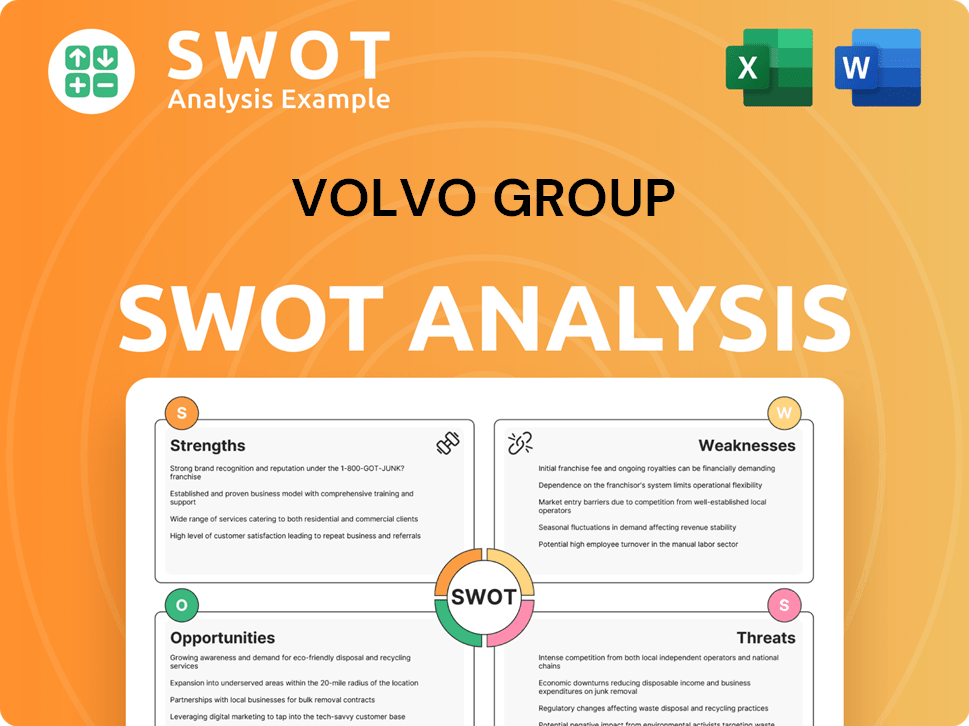
How Does Volvo Group Make Money?
The Growth Strategy of Volvo Group centers on diverse revenue streams and effective monetization strategies. The company generates revenue primarily through the sale of vehicles, engines, and services. In Q1 2024, the company's net sales reached SEK 131.4 billion, highlighting the scale of its operations.
A significant portion of revenue comes from the service business, including parts, maintenance, and financing. This segment provides a stable, recurring income stream. Service sales in 2023 increased by 19% to SEK 93.6 billion, representing 20% of total net sales, underscoring its importance.
Monetization strategies include direct product sales, often supported by financing through Volvo Financial Services, which had net sales of SEK 9.2 billion in Q1 2024. The company also offers bundled services like maintenance contracts. These strategies contribute to revenue diversification and customer engagement.
The revenue mix varies by segment and region. The truck segment is typically the largest contributor, followed by construction equipment and Volvo Penta. The focus on expanding the service business reflects a broader industry trend towards recurring revenue models.
- New Vehicle Sales: Trucks, buses, and construction equipment sales form a major revenue stream.
- Service Business: Includes parts, maintenance, repair contracts, and financing, providing recurring income.
- Marine and Industrial Engines: Sales of engines for various applications.
- Financing Solutions: Volvo Financial Services supports equipment purchases, generating interest and fees.
Volvo Group PESTLE Analysis
- Covers All 6 PESTLE Categories
- No Research Needed – Save Hours of Work
- Built by Experts, Trusted by Consultants
- Instant Download, Ready to Use
- 100% Editable, Fully Customizable
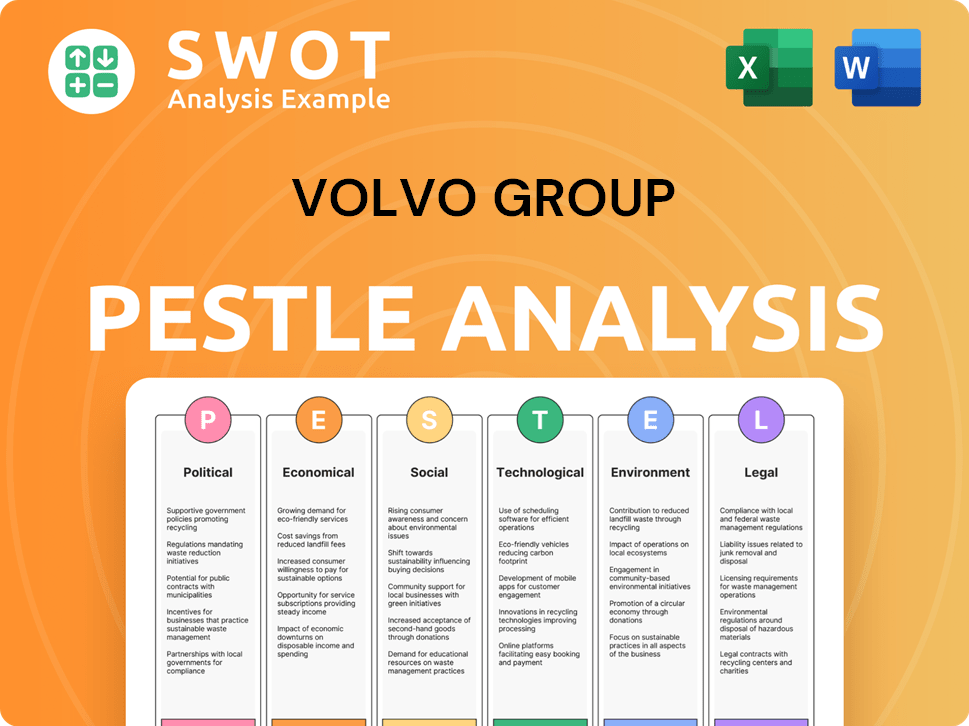
Which Strategic Decisions Have Shaped Volvo Group’s Business Model?
The Volvo Group has a rich history, marked by significant milestones and strategic moves that have shaped its operational and financial performance. A pivotal shift in recent years has been the accelerated focus on electrification and autonomous solutions. For example, Volvo Trucks began serial production of heavy-duty electric trucks in 2022, a major milestone in its sustainability roadmap. This move was a direct response to increasing regulatory pressures and growing customer demand for greener transportation solutions.
The company has navigated various operational and market challenges, including global supply chain disruptions, particularly during the COVID-19 pandemic and subsequent geopolitical events. Volvo Group responded by strengthening its supply chain resilience, optimizing production processes, and adapting its operational footprint to minimize impact. Regulatory hurdles, such as stricter emission standards, have also driven significant investment in research and development, leading to the introduction of more fuel-efficient and environmentally friendly products. The company continues to adapt to new trends by investing heavily in R&D, exploring new business models, and forging strategic alliances to maintain its competitive edge in a rapidly evolving industry.
The company's competitive advantages are multifaceted. Its strong brand strength, built on a reputation for safety, quality, and reliability, provides a significant edge in the market. Technological leadership, particularly in the development of electric and autonomous solutions, positions the company at the forefront of industry innovation. Economies of scale, derived from its global manufacturing footprint and extensive distribution network, allow for cost efficiencies and competitive pricing. Furthermore, its comprehensive ecosystem of products, services, and financing solutions creates a sticky customer base and fosters long-term relationships. For more insights into the company's target audience, consider reading about the Target Market of Volvo Group.
In 2023, Volvo Group delivered approximately 140,000 trucks globally, demonstrating resilience amid supply chain constraints. The company has expanded its electric truck offerings, with several models now in serial production. Strategic partnerships, such as the collaboration with Daimler Truck and Traton Group, are crucial for building a high-performance charging network in Europe.
The company is actively investing in electrification and autonomous solutions to meet evolving market demands. Volvo has been focusing on strengthening its supply chain to mitigate disruptions. The company is also exploring new business models, including offering comprehensive service packages to enhance customer value and create long-term relationships.
Volvo Group benefits from its strong brand reputation, technological leadership in electric and autonomous vehicles, and a global manufacturing footprint. The company's commitment to sustainability and innovation positions it well in a changing industry. The company's extensive product portfolio and service offerings create a robust ecosystem for customer retention.
In 2024, analysts project continued growth in the electric truck segment, with Volvo expected to increase its market share. The company's financial reports for 2023 showed a solid performance, despite ongoing challenges. The company's focus on cost efficiencies and operational improvements is expected to further enhance profitability.
The Volvo Group is concentrating on several key areas to maintain its competitive edge and drive future growth. These include accelerating the transition to electric and autonomous vehicles, strengthening supply chain resilience, and expanding its service offerings.
- Electrification: Expanding its range of electric trucks and buses.
- Autonomous Solutions: Investing in autonomous driving technology for various applications.
- Sustainability: Reducing carbon emissions across its operations and products.
- Service Expansion: Offering comprehensive service and financing solutions.
Volvo Group Business Model Canvas
- Complete 9-Block Business Model Canvas
- Effortlessly Communicate Your Business Strategy
- Investor-Ready BMC Format
- 100% Editable and Customizable
- Clear and Structured Layout
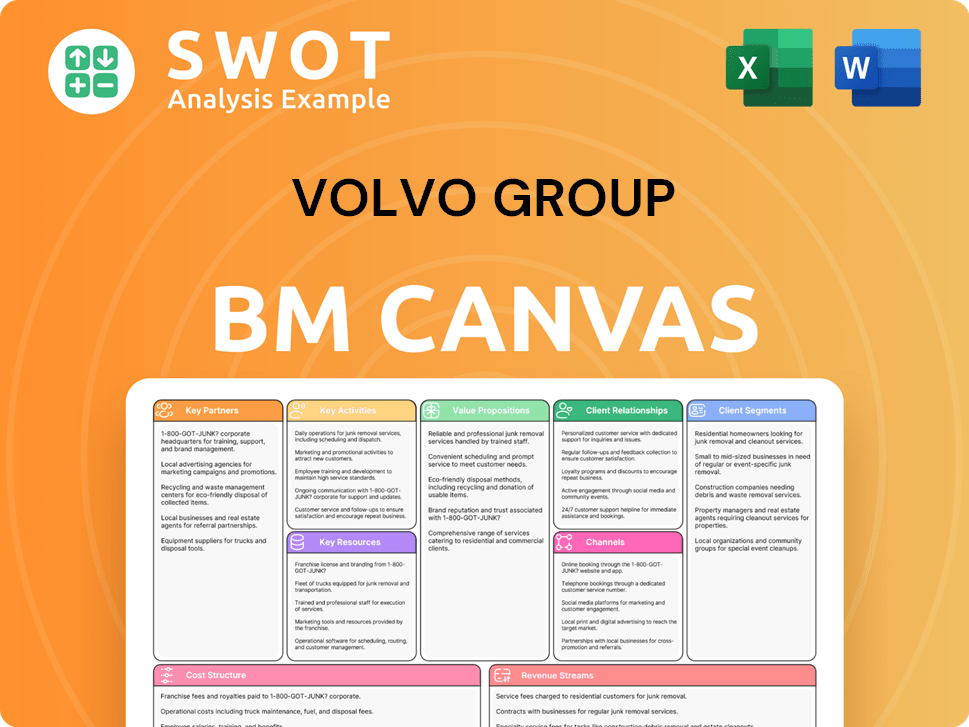
How Is Volvo Group Positioning Itself for Continued Success?
The Volvo Group holds a strong position in the global commercial transport and infrastructure sectors. It competes with major players like Daimler Truck and Traton Group. The company benefits from a solid market share in heavy-duty trucks and construction equipment, supported by its worldwide presence and customer loyalty. Its brand recognition and reputation contribute significantly to its competitive standing.
However, the Volvo company faces risks such as evolving regulations, particularly concerning emissions. The emergence of new competitors in electric vehicles and autonomous driving poses a challenge. Technological advancements and changing consumer preferences also require continuous innovation. Economic downturns and geopolitical instability can impact demand, affecting revenue and profitability. The Volvo business must adapt to these challenges to maintain its market position.
Volvo Group is a leading manufacturer of trucks, buses, construction equipment, and marine and industrial engines. It competes in a global market with major rivals. The company’s strong brand and focus on innovation give it a competitive edge.
Regulatory changes, especially regarding emissions, require significant investment. The rise of electric vehicles and autonomous driving presents new competition. Economic downturns and geopolitical instability can affect demand.
Volvo Group is focusing on sustainable transport solutions, particularly electromobility. The company aims for 35% of its truck sales to be electric by 2030. Investment in autonomous driving and connected services is also central to its strategy.
The company is expanding its electric vehicle portfolio. It is investing in charging infrastructure and developing autonomous driving technologies. Volvo Group emphasizes innovation, customer-centricity, and sustainability.
Volvo Group is actively pursuing strategic initiatives to sustain and expand its market position. The company is committed to sustainable transport and infrastructure solutions, with a strong focus on electromobility. Continued investment in autonomous driving technologies and connected services is also central to its future strategy. Leadership emphasizes innovation, customer-centricity, and sustainability as pillars of its future growth. The company plans to sustain its profitability by leveraging its strong brand, technological leadership, and comprehensive service offerings. For more insights, consider reading about the analysis of Volvo Group.
Volvo Group is focusing on several key areas to drive future growth and maintain its competitive edge. These strategies include expanding its electric vehicle offerings and investing in charging infrastructure. The company is also prioritizing the development of autonomous driving technologies and connected services to enhance efficiency and safety for its customers.
- Electromobility: Expanding the electric vehicle portfolio across all segments.
- Autonomous Driving: Investing in technologies to improve efficiency and safety.
- Connected Services: Enhancing customer solutions through digital connectivity.
- Sustainability: Focusing on sustainable transport and infrastructure solutions.
Volvo Group Porter's Five Forces Analysis
- Covers All 5 Competitive Forces in Detail
- Structured for Consultants, Students, and Founders
- 100% Editable in Microsoft Word & Excel
- Instant Digital Download – Use Immediately
- Compatible with Mac & PC – Fully Unlocked
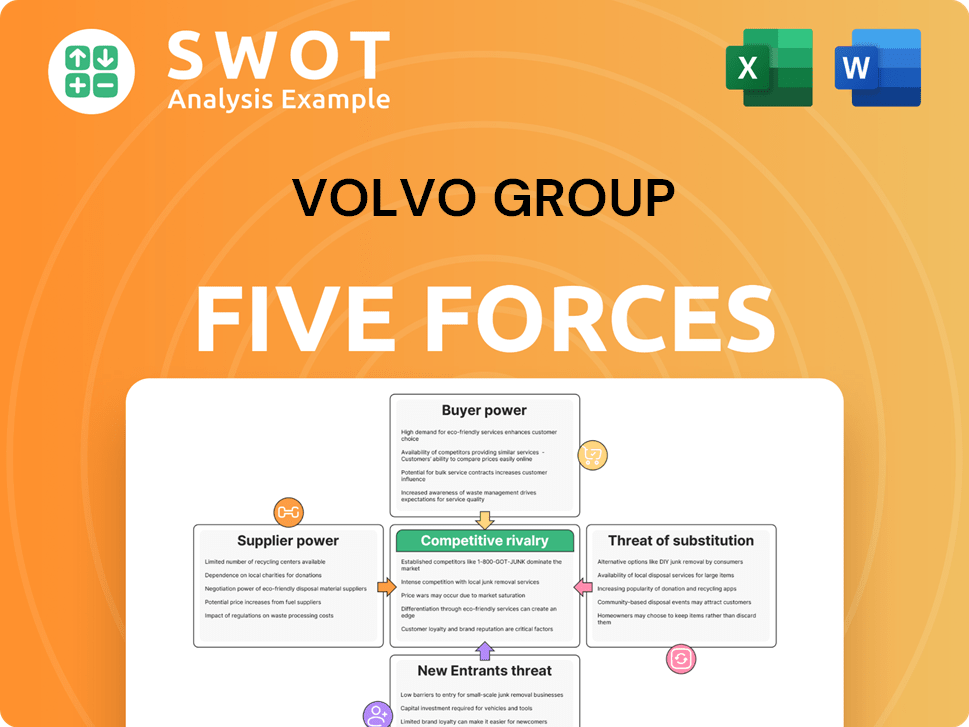
Related Blogs
- What are Mission Vision & Core Values of Volvo Group Company?
- What is Competitive Landscape of Volvo Group Company?
- What is Growth Strategy and Future Prospects of Volvo Group Company?
- What is Sales and Marketing Strategy of Volvo Group Company?
- What is Brief History of Volvo Group Company?
- Who Owns Volvo Group Company?
- What is Customer Demographics and Target Market of Volvo Group Company?
Disclaimer
All information, articles, and product details provided on this website are for general informational and educational purposes only. We do not claim any ownership over, nor do we intend to infringe upon, any trademarks, copyrights, logos, brand names, or other intellectual property mentioned or depicted on this site. Such intellectual property remains the property of its respective owners, and any references here are made solely for identification or informational purposes, without implying any affiliation, endorsement, or partnership.
We make no representations or warranties, express or implied, regarding the accuracy, completeness, or suitability of any content or products presented. Nothing on this website should be construed as legal, tax, investment, financial, medical, or other professional advice. In addition, no part of this site—including articles or product references—constitutes a solicitation, recommendation, endorsement, advertisement, or offer to buy or sell any securities, franchises, or other financial instruments, particularly in jurisdictions where such activity would be unlawful.
All content is of a general nature and may not address the specific circumstances of any individual or entity. It is not a substitute for professional advice or services. Any actions you take based on the information provided here are strictly at your own risk. You accept full responsibility for any decisions or outcomes arising from your use of this website and agree to release us from any liability in connection with your use of, or reliance upon, the content or products found herein.